Check out my owl photos in June/July 2025 RANGER RICK by clicking link below.

Check out my owl photos in June/July 2025 RANGER RICK by clicking link below.
A pair of northern hawk owls check out the view from atop a prospective nesting cavity. Hawk owls, like other owls, do not build a nest but use natural cavities and bowled out snags. The male establishes a territory that includes potential nests sites, but it seems to be the female who makes the final choice of snags.
After settling on another snag, the female incubates her eggs. Hawk owls nest early, usually in late April and will endure winter conditions.
Check out my photo story about northern hawk owls in the May 2018 issue of RANGER RICK, Just click the link below.
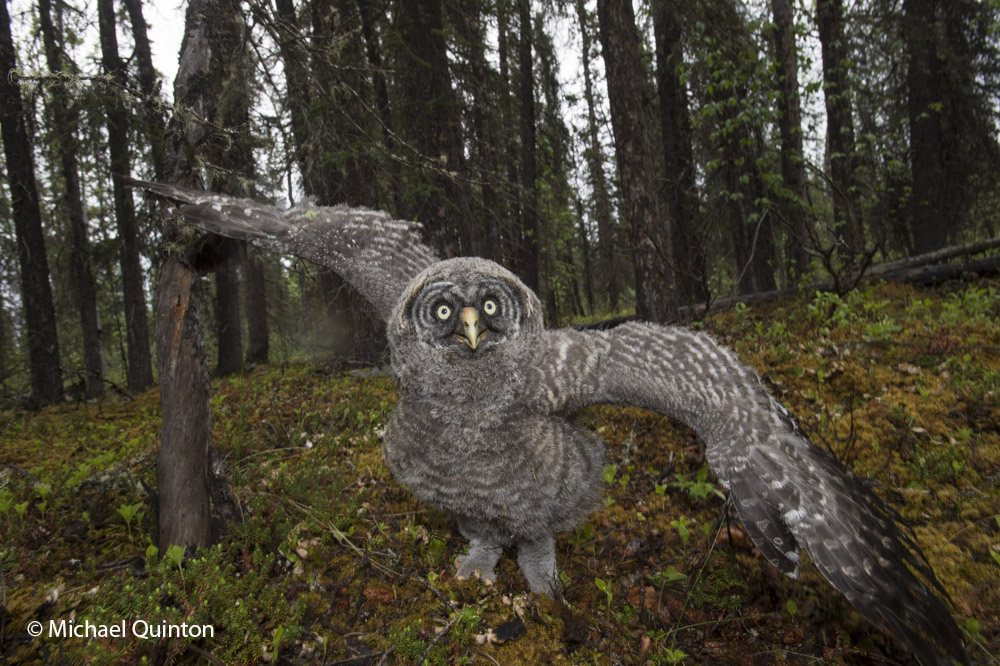 At nearly four weeks a fledged great gray owlet has jumped from its nest to the forest floor. Free from the confines of the nest, (I too am finally freed from the solitary confinement of my photo blind) the owlet walks and leaps to a place to perch.
At nearly four weeks a fledged great gray owlet has jumped from its nest to the forest floor. Free from the confines of the nest, (I too am finally freed from the solitary confinement of my photo blind) the owlet walks and leaps to a place to perch.
Fledged owlets move about fifty to a hundred feet every day, picking out a slanting tree to climb. The ground is a dangerous place for the young, flightless owls. The mobile owl family becomes more difficult to locate by the day.
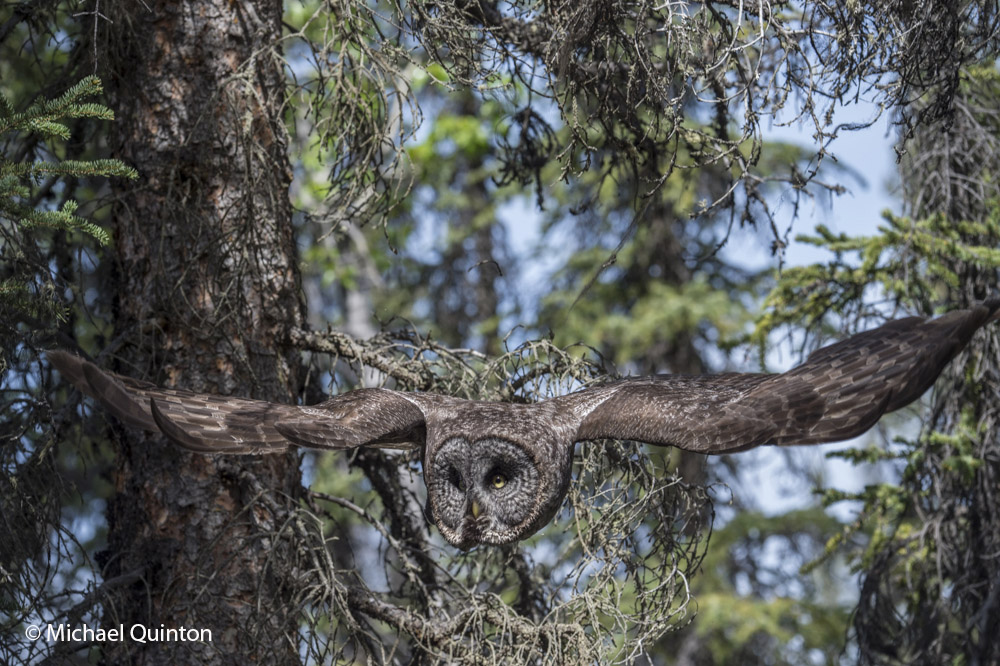 Adults continue to care for their owlets. The female (above), usually staying near the owlets, will do some hunting when an opportunity presents itself.
Adults continue to care for their owlets. The female (above), usually staying near the owlets, will do some hunting when an opportunity presents itself.
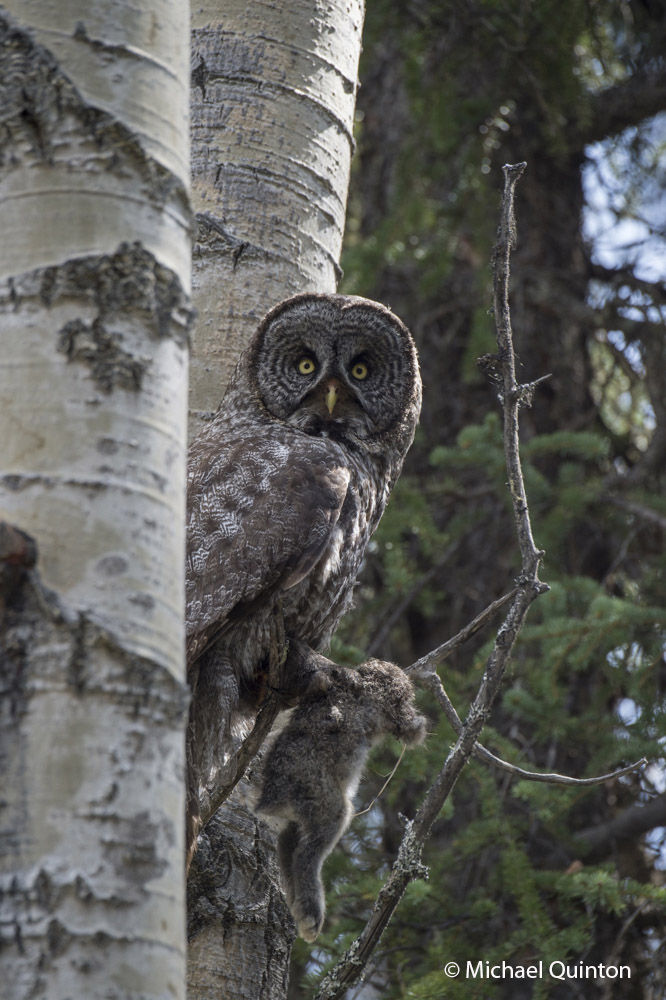 The female with a young snowshoe hare delivered by her mate.
The female with a young snowshoe hare delivered by her mate.
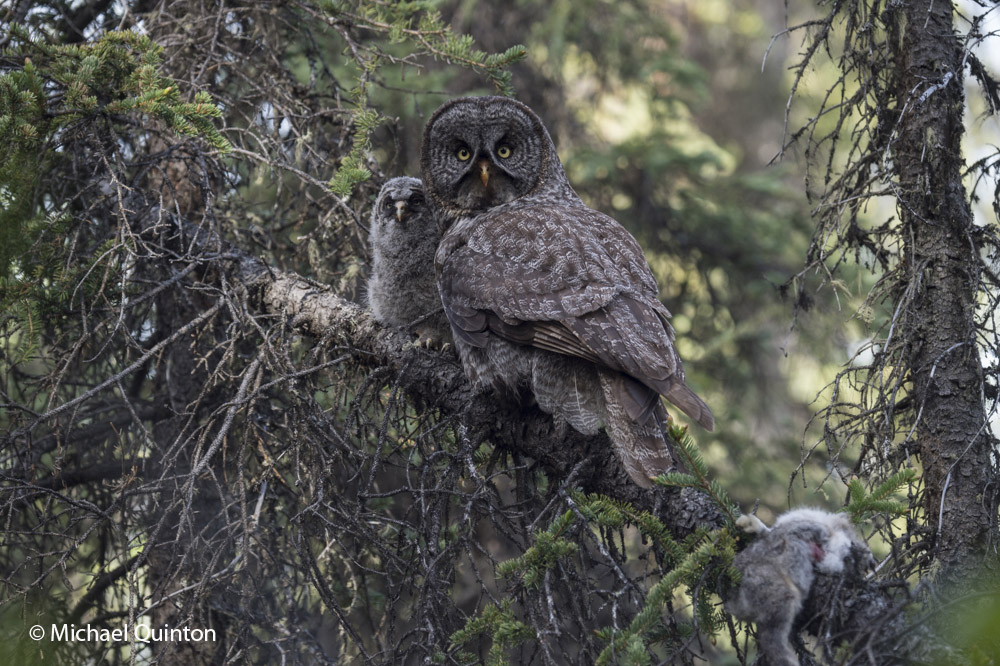 The snowshoe hare, large prey for a great gray owl, will feed her and her owlets for a day. The prey is cached on the ground between feedings.
The snowshoe hare, large prey for a great gray owl, will feed her and her owlets for a day. The prey is cached on the ground between feedings.
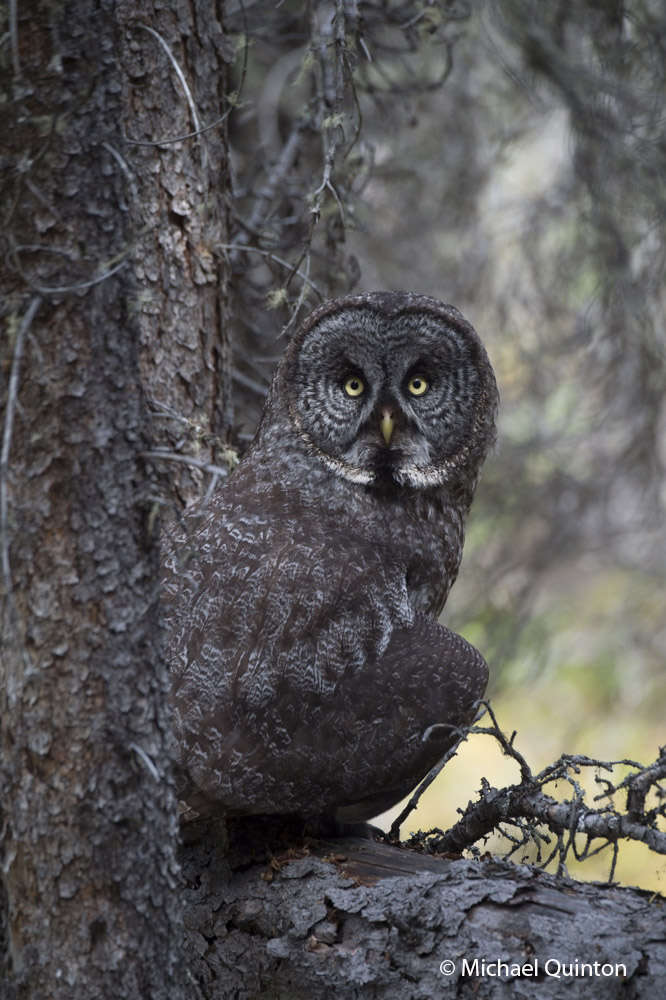 Female perches on log after caching the snowshoe hare.
Female perches on log after caching the snowshoe hare.
Adult female drinking.
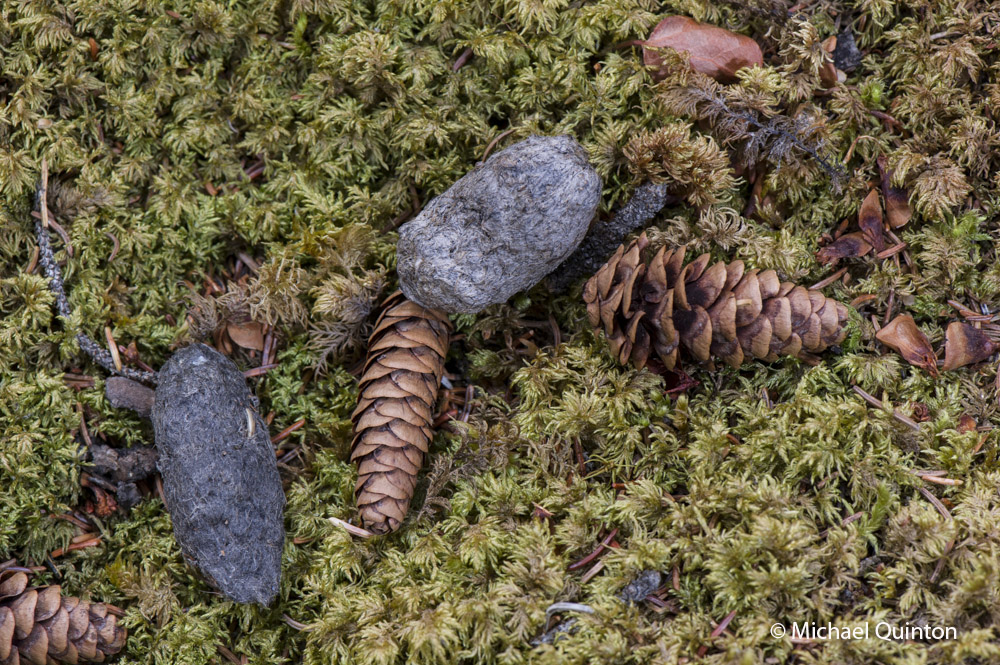 Regurgitated great gray owl pellets and white spruce cones on a bed of sphagnum moss below an owlets perch.
Regurgitated great gray owl pellets and white spruce cones on a bed of sphagnum moss below an owlets perch.
 Female delivers her owlet a freshly caught red-backed vole. Fledged owlets swallow voles whole.
Female delivers her owlet a freshly caught red-backed vole. Fledged owlets swallow voles whole.
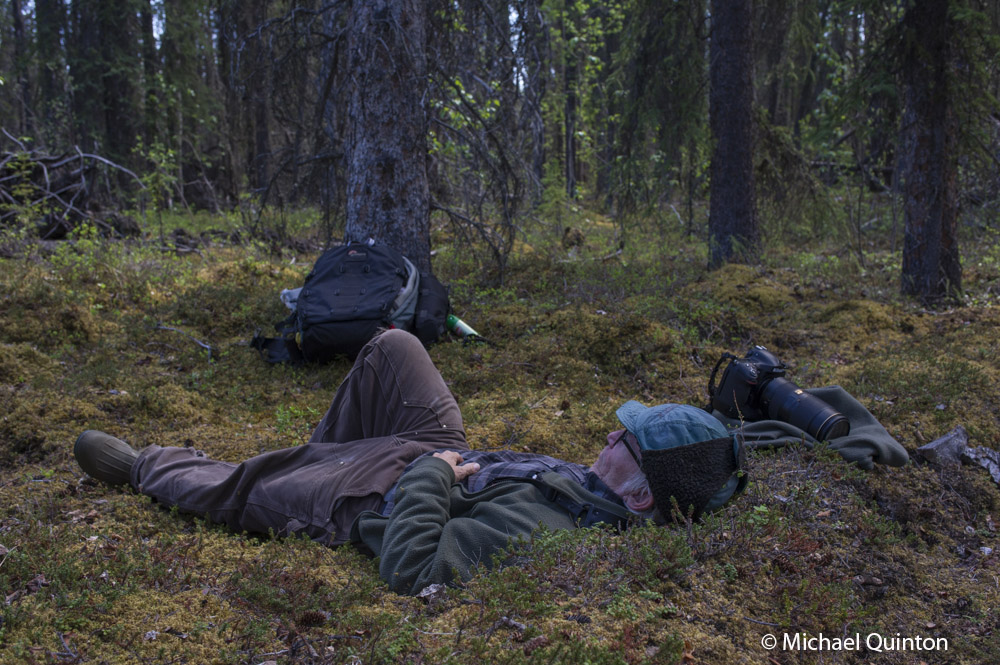 A tough job but it must be done.
A tough job but it must be done.
Female great gray owl holds another red-backed vole just delivered by her mate. The well fed owlets are not hungry at the moment so the vole will be placed in the nest for later. For nearly four weeks I had a rare and intimate view of the owls family life at the nest.
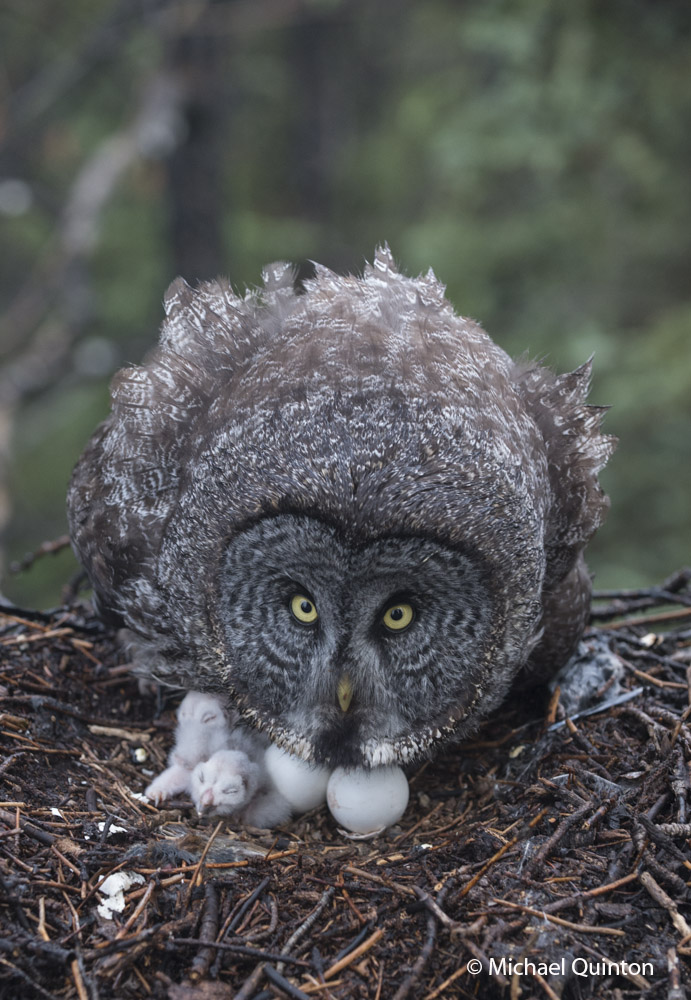 As the female raises up from her brooding, she gives me my first look at the tiny owlets.
As the female raises up from her brooding, she gives me my first look at the tiny owlets.
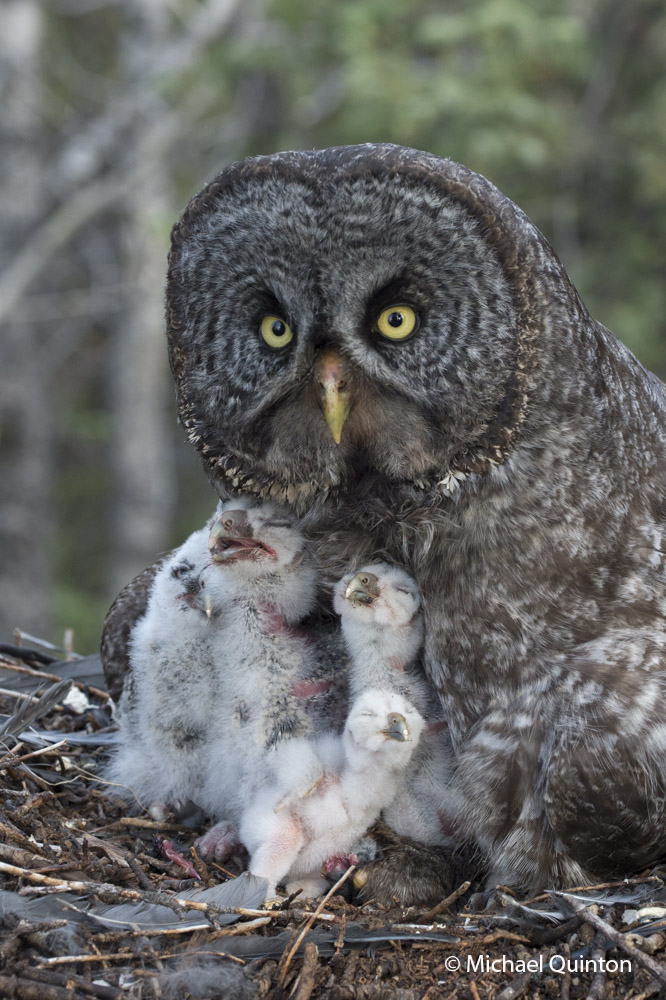 The owlets hatching over a period of about a week account for their age and size difference. Competition among the owls for food favors the older owlets. The smallest owlet, here just a couple of days old, could not hold its own and one morning it was gone.
The owlets hatching over a period of about a week account for their age and size difference. Competition among the owls for food favors the older owlets. The smallest owlet, here just a couple of days old, could not hold its own and one morning it was gone.
https://youtu.be/gG-pWZZjKt4
Watch video of male delivering a red-backed vole. (above)
After a couple of weeks there is no longer a need for constant brooding and the female finally gets a little time to herself. But even then she stays close and alert for danger. One day a pair of ravens hung around the nest in an attempt to harass her from the nest long enough to steal a chick. She held tight and her mate arrived to chase the ravens about. Eventually the ravens left.
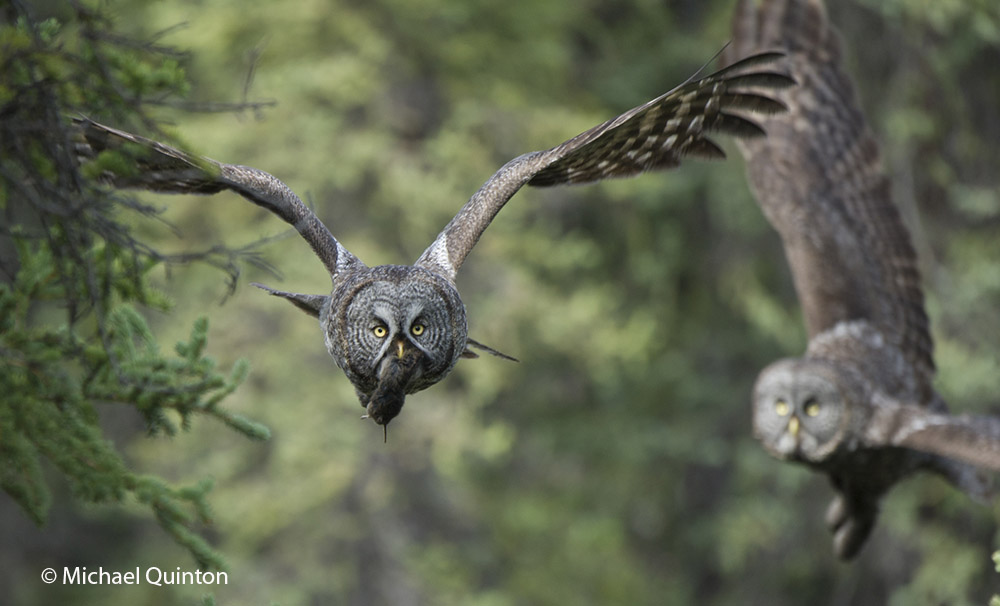 As the female perched near the nest her mate arrives with prey and she follows him in.
As the female perched near the nest her mate arrives with prey and she follows him in.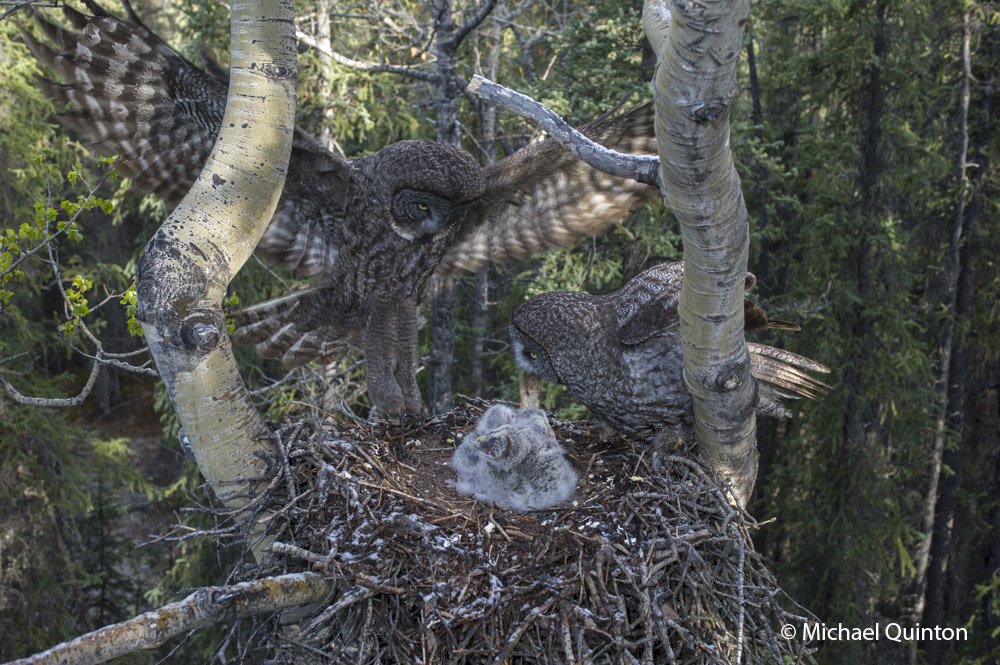
Arriving at the nest the female takes possession of the red-backed vole from her mate. (right) After a brief pause at the nest the male is off again to continue hunting. (below)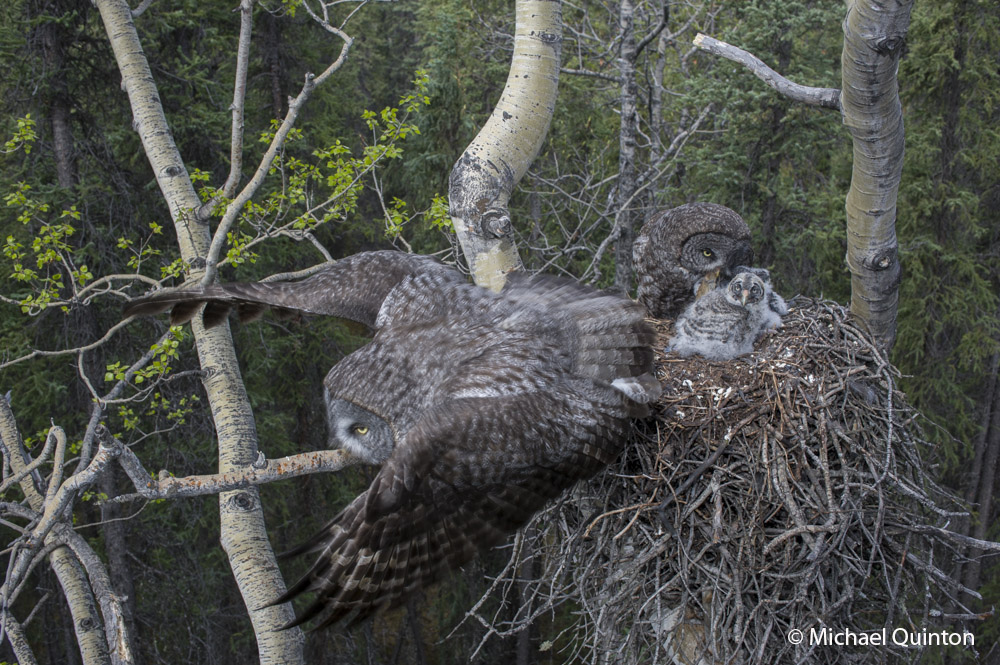
Visit next week for the final post in this series, SECRET LIFE OF A FOREST HUNTER-PART THREE
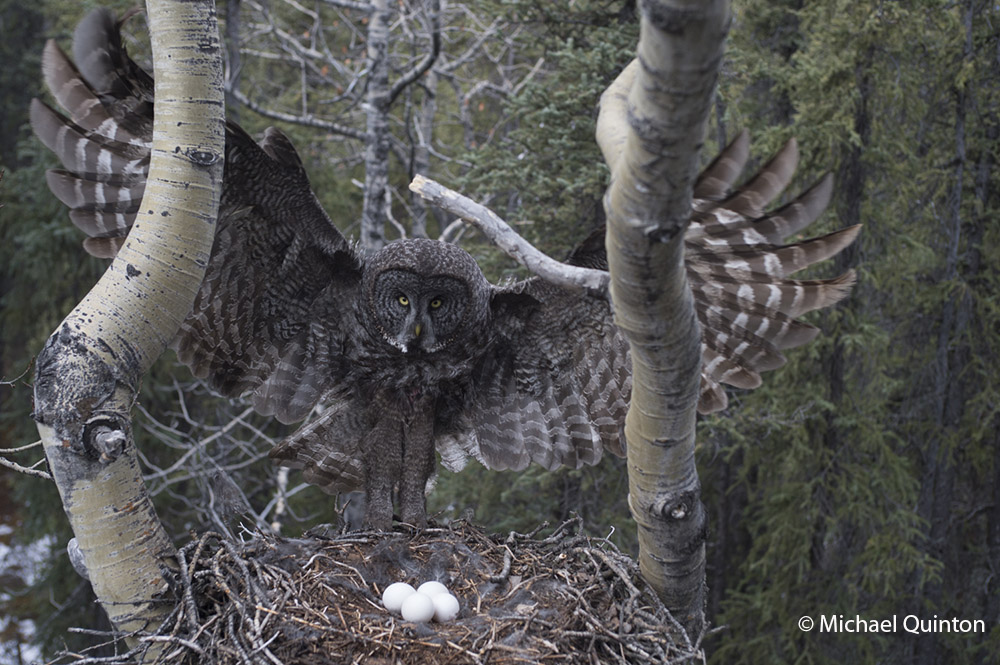 A female great gray owl spreads her wings as she gently lands on the edge of her nest to resume incubating her four eggs. For two months this nest is the nucleus of activity for a pair of great gray owls. Owls do not build their own nests. Instead they use a variety of ready-made and vacant nests, like this one built many years before by northern goshawks. The great grays I had photographed three decades ago in Idaho prefered the bowled out tops of large broken pine trees for their nests.
A female great gray owl spreads her wings as she gently lands on the edge of her nest to resume incubating her four eggs. For two months this nest is the nucleus of activity for a pair of great gray owls. Owls do not build their own nests. Instead they use a variety of ready-made and vacant nests, like this one built many years before by northern goshawks. The great grays I had photographed three decades ago in Idaho prefered the bowled out tops of large broken pine trees for their nests.
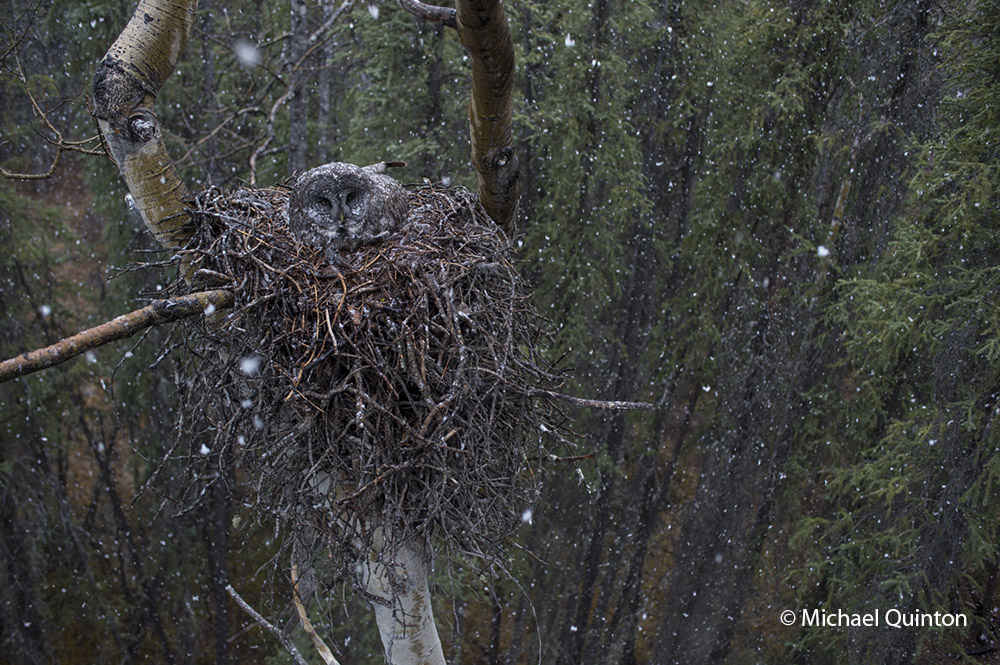 Eggs laid in the third week of April must be protected from the weather, as incubation begins with the first egg. The female does all the incubating and will sit on her eggs for thirty days.
Eggs laid in the third week of April must be protected from the weather, as incubation begins with the first egg. The female does all the incubating and will sit on her eggs for thirty days.
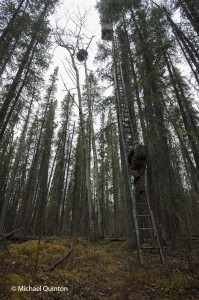 To gain access to the nesting great grays, more than fifty feet above the forest floor, I scabbed two long extensions ladders together and added an additional extension using two by fours. I had located the nest thirteen years ago. The three-foot wide nest was built by northern goshawks in a towering quaking aspen. Every spring I’d hike to the remote nest site to check its status. Goshawks had used the nest only once during the last thirteen years.
To gain access to the nesting great grays, more than fifty feet above the forest floor, I scabbed two long extensions ladders together and added an additional extension using two by fours. I had located the nest thirteen years ago. The three-foot wide nest was built by northern goshawks in a towering quaking aspen. Every spring I’d hike to the remote nest site to check its status. Goshawks had used the nest only once during the last thirteen years.
From my self-imposed confinement in the lofty, swaying photo blind, I witnessed much more than just the daily activities of the great gray owls. The female owl and I watched red squirrels, that rarely seen red squirrel predator, the marten, groups of migrating caribou, and a variety of bird life. Early one morning, not long after arriving, a huffing grizzly bear sow and yearling cub who had caught my scent quickly moved off beneath the blind. Once a curious cow moose who could hear my camera clicking finally looked up.
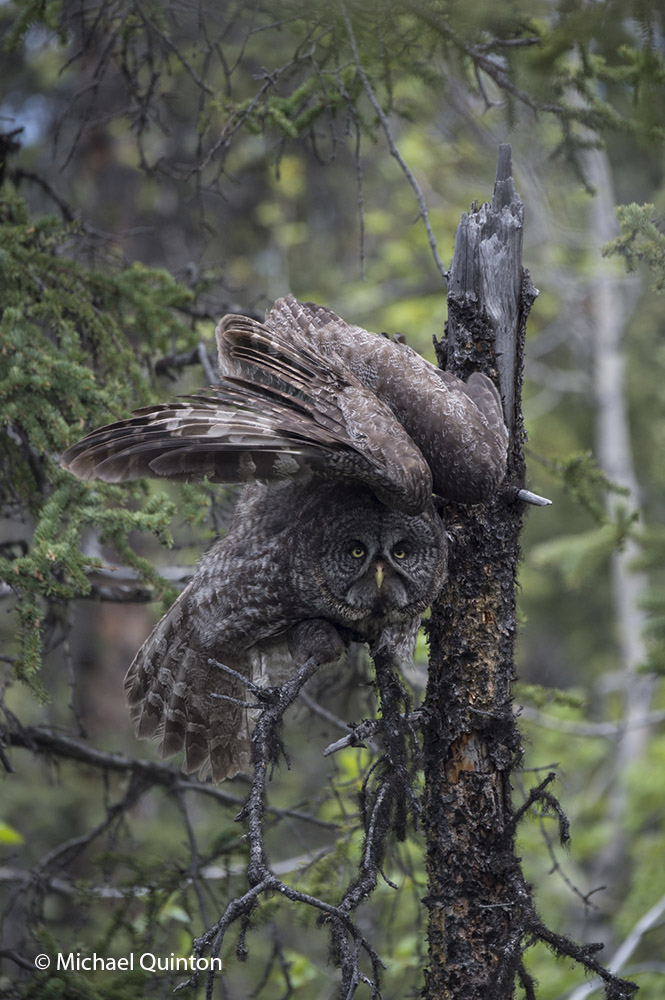 A couple of times a day the female flies off the nest to drink, cast her pellet and perhaps stretch before returning to her precious clutch of eggs.
A couple of times a day the female flies off the nest to drink, cast her pellet and perhaps stretch before returning to her precious clutch of eggs.
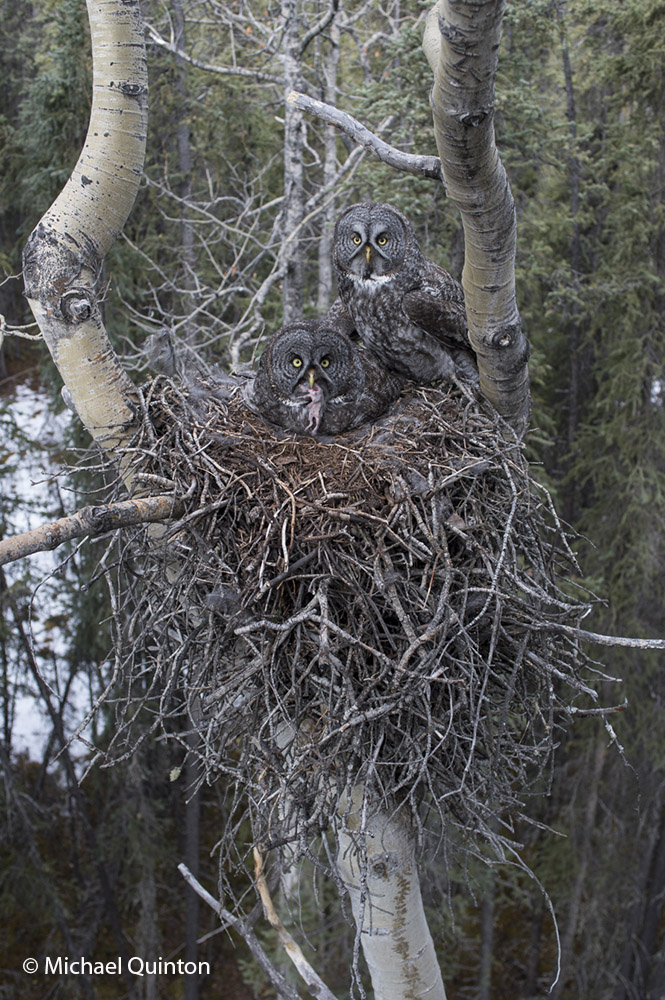 The male hunts for his mate and has just arrived with prey, a baby red squirrel. The male, who hunts during the day using sight and sound, is an opportunist and preys on a variety of small birds and mammals. Red-backed voles are by far the most important prey but shrews, small birds, and young snowshoe hares are also prey. Adult red squirrels are usually too alert and quick to be given much attention by the hunting male. But young squirrels, probably raided from their grass and sphagnum nests, are regularly on the menu.
The male hunts for his mate and has just arrived with prey, a baby red squirrel. The male, who hunts during the day using sight and sound, is an opportunist and preys on a variety of small birds and mammals. Red-backed voles are by far the most important prey but shrews, small birds, and young snowshoe hares are also prey. Adult red squirrels are usually too alert and quick to be given much attention by the hunting male. But young squirrels, probably raided from their grass and sphagnum nests, are regularly on the menu.
For the past six weeks or so we have been delighted by the nocturnal trilling song of a little boreal owl. I believe the male has claimed our little forested yard as his own. He sings almost every night from one of the old northern flicker cavities in the black spruce stand surrounding our home. With his little round head filling up the hole he serenades the darkness, or sometimes accompanies the glow and flicker of the aurora.
Click on the left side of the audio bar to hear the song of the boreal owl.
The boreal owl is a nocturnal hunter of voles, shrews, flying squirrels and small birds.
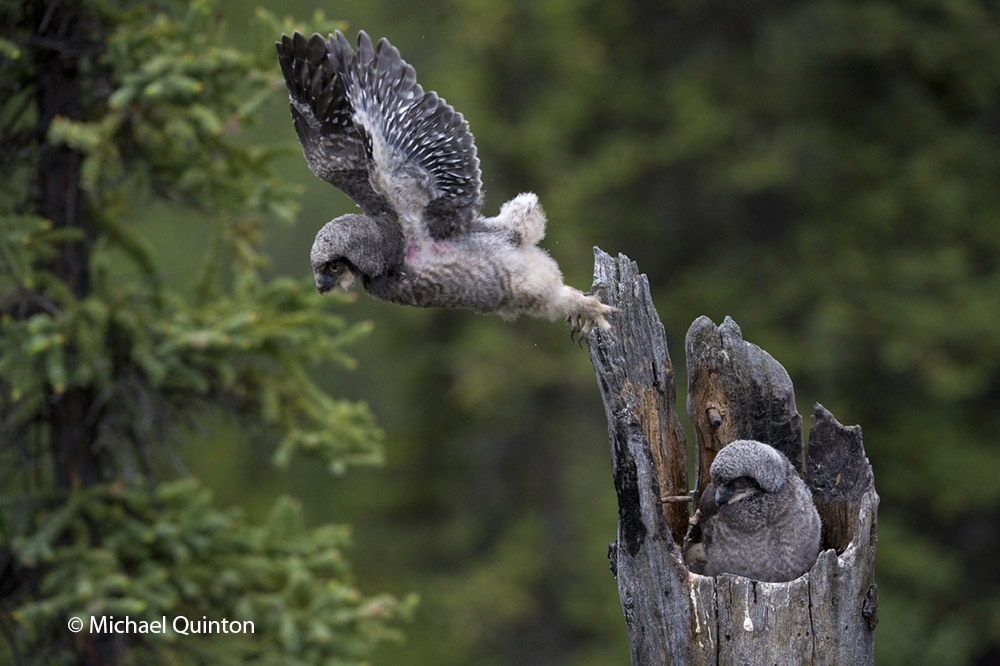 Though unable to fly three-week old hawk owlets are ready to make the leap.
Though unable to fly three-week old hawk owlets are ready to make the leap.
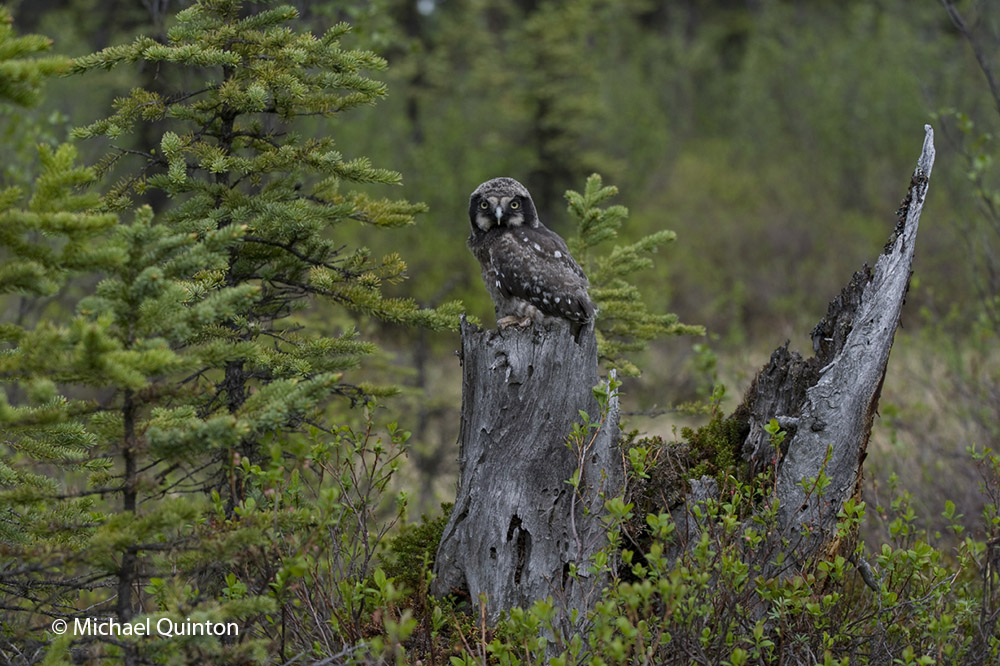 For young hawk owls the ground is a dangerous place. Continue reading
For young hawk owls the ground is a dangerous place. Continue reading
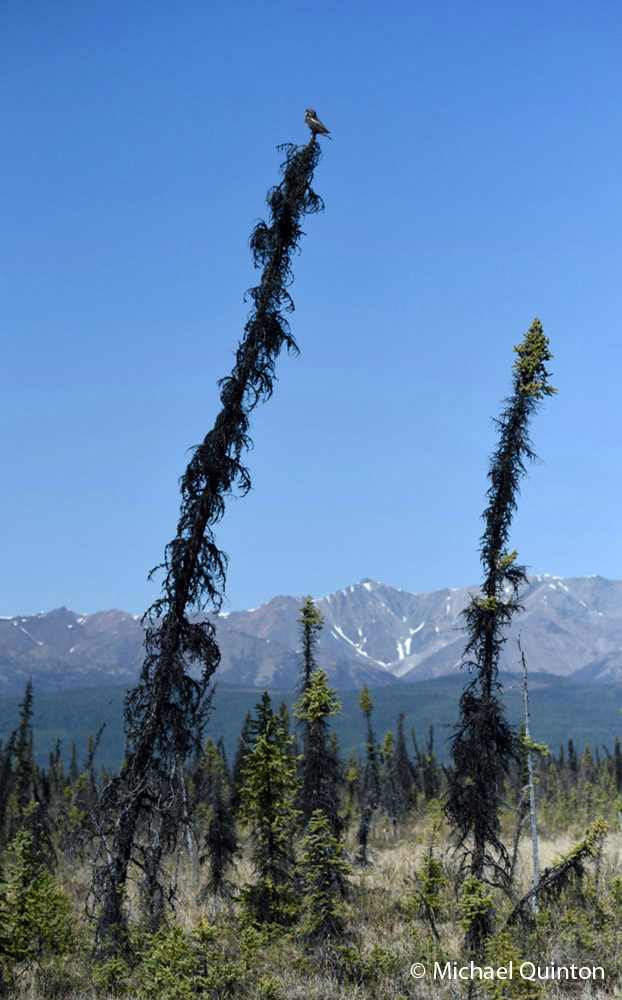 A northern hawk owl perched atop a dead, black spruce overlooking its preferred hunting grounds, an Alaskan muskeg wetland.
A northern hawk owl perched atop a dead, black spruce overlooking its preferred hunting grounds, an Alaskan muskeg wetland.
The northern hawk owl is named after its hawk-like hunting behavior. Like hawks, the hawk owl hunts by day using its keen eyesight to spot small birds and mammals. The red-backed vole is by far the most important prey species. But the hawk owl is an opportunist and other species of voles and several species of shrews are also caught. During those years when snowshoe hares are plentiful, hawk owls will add these much larger prey species to their list, as will many species of birds from the tiny, common red-poll to birds up to the size of ptarmigan. Continue reading
BY DAY
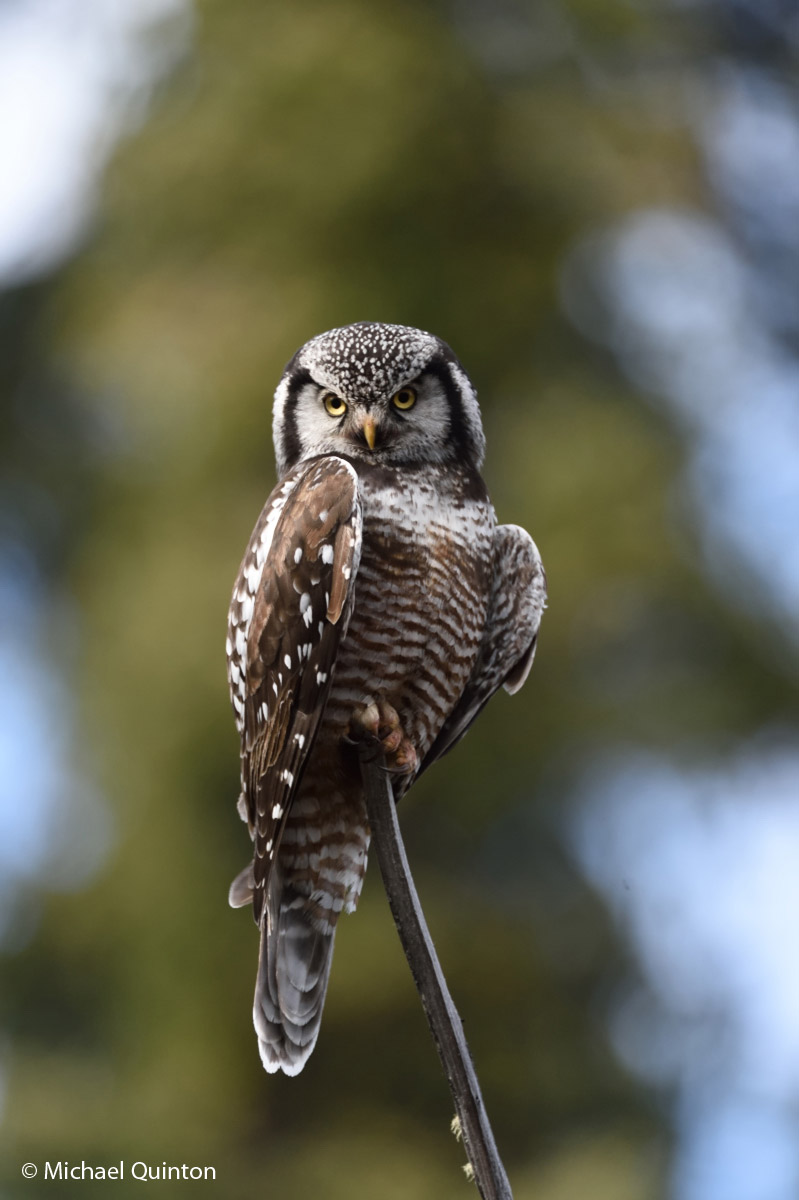 Adult male northern hawk owl is active during the day.
Adult male northern hawk owl is active during the day.
For a few weeks I have been photographing a pair of northern hawk owls that have nested in a stand of tall white spruce. Hawk owl populations are cyclic and for the past three years they have been rare in my part Alaskan interior. Over the past twenty years, I have been trying to capture their little known life history. In those twenty years I have found only six or seven active nests. Continue reading
 Adult male is a night hunter and his prey consisting of small birds and mammals, such as this red-backed vole, are located by sight and sound.
Adult male is a night hunter and his prey consisting of small birds and mammals, such as this red-backed vole, are located by sight and sound.
Since nesting began, the male has been impossible to locate in the dark, damp forest near Slana, Alaska. But each evening he arrives at the nest site to deliver prey to the owlets. As the Alaskan days grow shorter, the male becomes active as twilight engulfs the stand of tall white spruce and poplar. He is the sole provider for the five owlets snuggled inside a hollow stub. The female abandoned her owlets when they were three weeks of age. They no longer needed brooding so apparently her role is complete. Continue reading